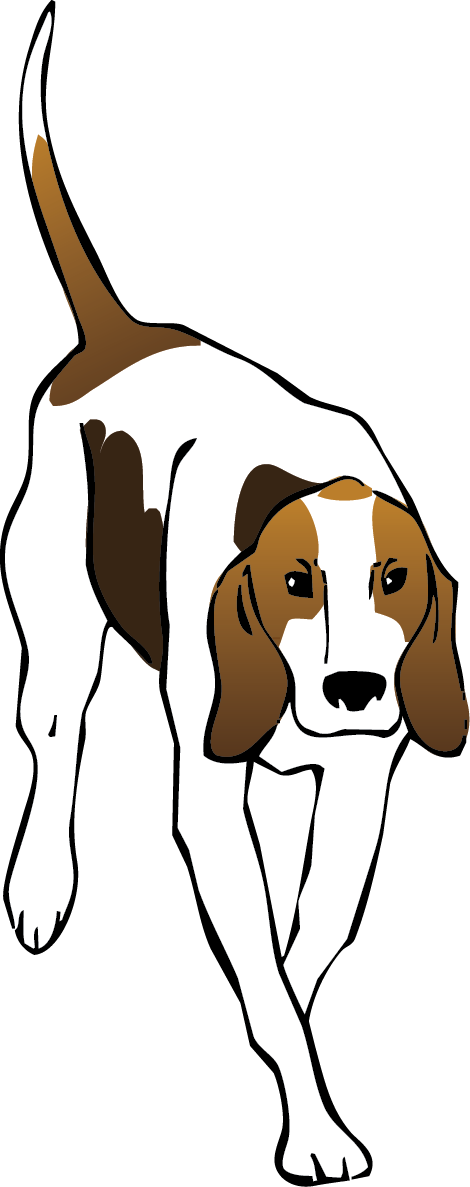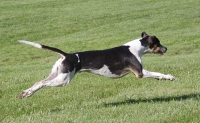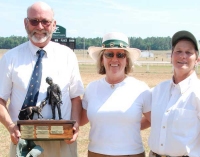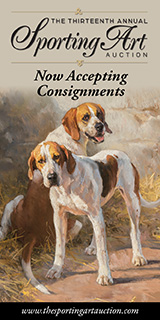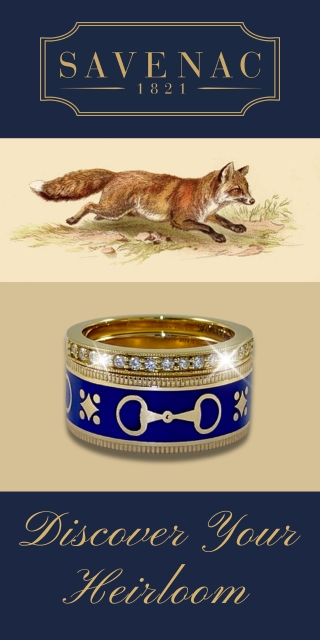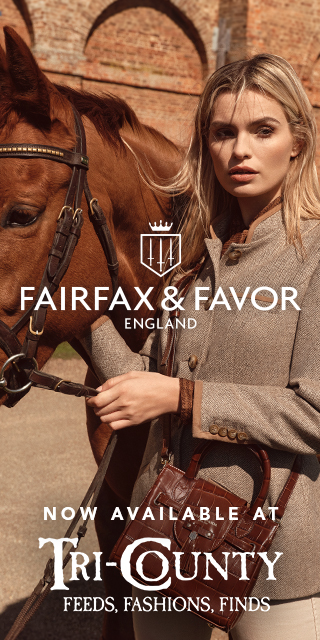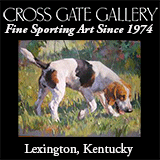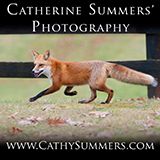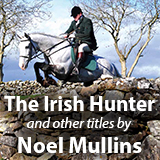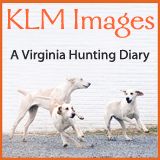penn-marydel
Codie Hayes and Her Hounds: A Love Story
At age 12, Codie Hayes showed Rose Tree Needy to the Grand Championship at the 2004 Virginia Foxhound Show, the first time ever for a Penn-Marydel. / Lauren Giannini photoFrom the moment Codie Jane Hayes became aware of the world around her, she took to hounds. She progressed from crawling to toddling among the pack of Penn-Marydel foxhounds bred and hunted by her grandfather Jody Murtagh, Jr., ex-MFH. She was a wunderkind, totally at home with hounds and crazy about them. From the way hounds take to her, she was born with a gift—that coveted invisible thread connecting her to hounds wherever she goes.
In August 2014, Codie, twenty-two, became the professional huntsman for the Golden’s Bridge Hounds in North Salem, New York. This position at any hunt entails huge responsibilities, but after a glimpse into how she spent her childhood and teen years, there’s no doubt that she has been training to be huntsman since she came into the world.
The Penn-Marydel Is Grand Champion at Virginia and Bryn Mawr
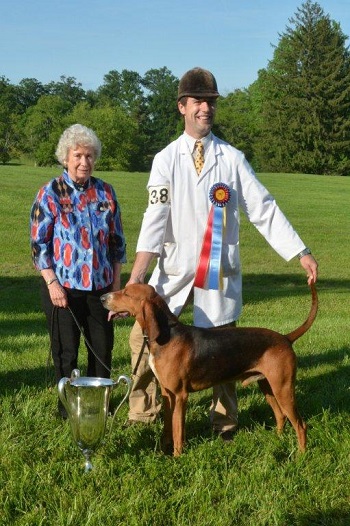 Joan Jones presents the Grand Championship Trophy for Golden's Bridge Phoenix to huntsman Ciaran Murphy. / Liz Callar photoFor the second time* in history, a Penn-Marydel foxhound was judged Grand Champion of the Virginia Foxhound Show. The William W. Brainard, Jr. Perpetual Cup was presented to Golden’s Bridge Phoenix 2012 at Morven Park in Leesburg on Sunday, May 25, 2014. Golden’s Bridge huntsman Ciaran Murphy showed the Champion.
Joan Jones presents the Grand Championship Trophy for Golden's Bridge Phoenix to huntsman Ciaran Murphy. / Liz Callar photoFor the second time* in history, a Penn-Marydel foxhound was judged Grand Champion of the Virginia Foxhound Show. The William W. Brainard, Jr. Perpetual Cup was presented to Golden’s Bridge Phoenix 2012 at Morven Park in Leesburg on Sunday, May 25, 2014. Golden’s Bridge huntsman Ciaran Murphy showed the Champion.
The following weekend, for the first time in foxhound history, the same Penn-Marydel repeated his stunning Virginia victory by being judged Grand Champion of Show at Bryn Mawr.
The Penn-Marydel as a breed is justifiably loved by its admirers for a number of reasons—nose, voice, biddability—none of which includes a reputation as the standard for foxhound beauty. Yet Golden’s Bridge Phoenix prevailed over the usual suspects so often in the Virginia lineup for the final class of the day: Live Oak Hounds (FL), Midland Foxhounds (GA), and Potomac Hunt (MD). At Bryn Mawr, Phoenix topped the other breed champions from the Blue Ridge Hunt (VA), Potomac Hunt, and GreenSpring Valley Hounds (MD).
Foxhounds With a Difference
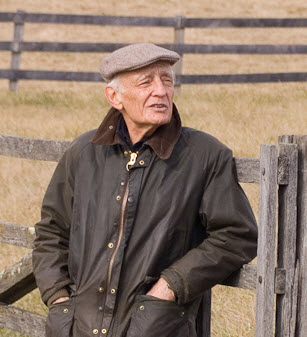 Mr. Stewart’s Cheshire Foxhounds (PA) boasts a sporting field of superb horsemen and women that love to gallop and take their own lines over the post-and-rail line fences in their country. Seven years ago, the Cheshire Masters and staff embarked on a bold experiment to breed a new foxhound for that country. Our feature article below tells of their decision to cross the The Old English (also called the Traditionally-Bred English) foxhound and the Penn-Marydel foxhound.
Mr. Stewart’s Cheshire Foxhounds (PA) boasts a sporting field of superb horsemen and women that love to gallop and take their own lines over the post-and-rail line fences in their country. Seven years ago, the Cheshire Masters and staff embarked on a bold experiment to breed a new foxhound for that country. Our feature article below tells of their decision to cross the The Old English (also called the Traditionally-Bred English) foxhound and the Penn-Marydel foxhound.
Their plan was a gamble because the two breeds are about as dissimilar in type as foxhounds get, and the crossing of the two types would produce litters that varied greatly from pup to pup. However, the Cheshire Masters and huntsman believed that the strong points of each type would tend to compensate for the perceived weaknesses in the other and result in a foxhound superior to either type.
Here are some examples of the perceived differences between the types. Just remember that generalizations are only generally valid!
The Cheshire Crossbred: A Bold Gamble
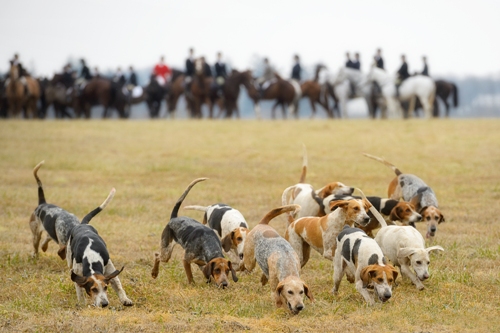 The new Cheshire Crossbreds combine the best traits of two disparate foxhound types / Jim Graham photo
The new Cheshire Crossbreds combine the best traits of two disparate foxhound types / Jim Graham photo
When an established hunt with a reputation for showing the best of sport to the best of horsemen in the best of countries comes up with a novel idea for breeding a better foxhound, and sees it through to fruition and success, one has to pay attention.
The venerable—one hundred years this season—Mr. Stewart’s Cheshire Foxhounds in Unionville, Pennsylvania traditionally hunted the Old English foxhound under the hunt’s founder W. Plunket Stewart and the active Mastership of his step-daughter, the late Mrs. John (Nancy Penn Smith) Hannum. Masters and members know the breed very well.
Ireland’s County Galway Foxhounds (The Blazers), another venerable hunt renowned for showing world-class sport, also hunts the Old English foxhound. Cheshire huntsman Ivan Dowling grew up following the Blazers, and he too knows the Old English foxhound very well.
History and familiarity notwithstanding, seven years ago the Cheshire Masters and their Galway-born huntsman Dowling decided to continue a breeding experiment begun two years earlier by former huntsman John Tullock. They committed to the notion of crossing the English foxhound with the Penn-Marydel foxhound—two disparate types—in the hope of making a better foxhound for their country. This was a chancy endeavor, understandably fraught with controversy within the hunt.
Cheshire Centennial Meet at Brooklawn
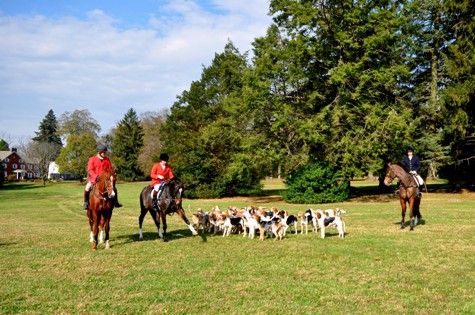 Cheshire Honorary Whipper-In Paddy Neilson, Huntsman Ivan Dowling, and professional whipper-in Stephanie Boyer at Brooklawn / Noel Mullins photo
Cheshire Honorary Whipper-In Paddy Neilson, Huntsman Ivan Dowling, and professional whipper-in Stephanie Boyer at Brooklawn / Noel Mullins photo
Mr. Stewart’s Cheshire Foxhounds (PA), founded in 1912, are celebrating their Centennial this season. W. Plunkett Stewart, a Philadelphia banker, set out to find the perfect hunting country and settled on the rolling hills, rich pastureland and extensive woods around Unionville. As what in modern terms could be classed as a committed environmentalist, he purchased thousands of acres of land and, before reselling, amended deeds to restrict development and nurture conservancy, clean water, and natural habitat. As a result of his efforts and the culture of conservation he passed on, the Cheshire hunting country today boasts thirty square miles and twenty-six thousand acres free from ribbon residential and commercial development that has allowed foxhunting and National Hunt racing to thrive.
Penn-Marydels Are Getting Respect
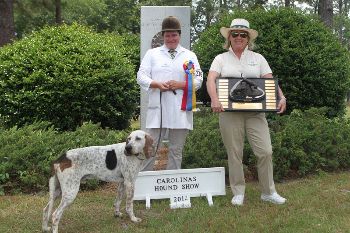 Unentered Aiken Trailer was Grand Champion of the Carolinas Hound Show to the delight of (l-r) huntsman Katherine Gunter and Linda McLean, MFH. / Louisa Davidson photoWith stunning examples of the modern English foxhound setting the beauty standard of our time, the Penn-Marydels have long been considered the ugly ducklings of the show ring. So outclassed were they that when shown in the same ring with the modern English or well-bred Crossbred, they never even earned a second glance from the judges.
Unentered Aiken Trailer was Grand Champion of the Carolinas Hound Show to the delight of (l-r) huntsman Katherine Gunter and Linda McLean, MFH. / Louisa Davidson photoWith stunning examples of the modern English foxhound setting the beauty standard of our time, the Penn-Marydels have long been considered the ugly ducklings of the show ring. So outclassed were they that when shown in the same ring with the modern English or well-bred Crossbred, they never even earned a second glance from the judges.
That view is changing, and we are seeing some spectacular examples of foxhound conformation in the Penn-Marydel ring. So good in fact, that in two cases at least the Penn-Marydel entry has eclipsed all others.
The Huntsman Introduces Himself
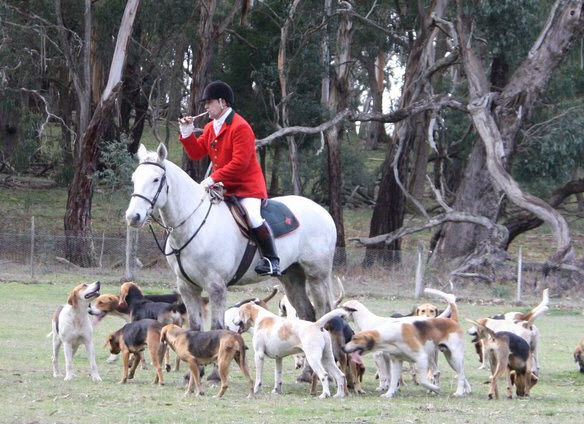 Andy Bozdan is the new huntsman for the Tennessee Valley Hunt. Here he calls in the Barwon hounds after a sharp hunt in Victoria, southern Australia.A dear friend used to keep a reminder tacked to her refrigerator. It was all about attitude. The essence of it was that attitude is the most important aspect in life. And it’s really the only thing over which we have total control.
Andy Bozdan is the new huntsman for the Tennessee Valley Hunt. Here he calls in the Barwon hounds after a sharp hunt in Victoria, southern Australia.A dear friend used to keep a reminder tacked to her refrigerator. It was all about attitude. The essence of it was that attitude is the most important aspect in life. And it’s really the only thing over which we have total control.
The Tennessee Valley Hunt just hired a new huntsman—Andy Bozdan—who will soon arrive in the States. Andy sent an email to his new hunt, introducing himself and explaining his perceptions of the job. It is so brimming with good attitude that, rather than extracting a few facts for a brief News bulletin, I thought you might enjoy reading Andy’s entire message. He wrote:
The Green Spring Valley Hounds at Dover and Dark Hollow
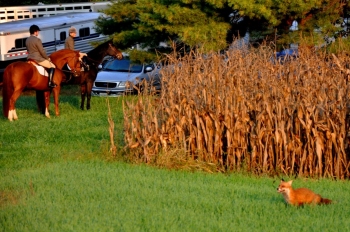
Slipping quietly away
Many of the MFHA-registered packs in North America have close associations with Ireland and the UK either through hunt staff, field members, jockeys, or through the many Irish and British field hunters and racehorses that grace their hunting fields. One such well known pack is the Green Spring Valley Hounds in Maryland, USA. They met a few weeks ago at Ned Finney’s farm at Dover and Dark Hollow, which is close to the Maryland Hunt Cup racecourse and Shawan Downs racecourse.
Live Oak Hounds Dominate at Virginia
Two hounds from the Live Oak kennels in Monticello, Florida, took top honors at the Virginia Foxhound Show on May 30, 2010 at Morven Park near Leesburg. English Foxhound Champion Live Oak Maximus 2009 (Live Oak Daniel 2007–Their Mistress 2006) was judged Grand Champion, and Crossbred Champion Live Oak Apache 2008 (Live Oak Mascot 2005–Their Apricot 2004) was named Reserve Grand Champion.
Why Worry Hounds Big Winners at Carolinas
The Why Worry Hounds and MFHs George and Jeannie Thomas made bold statements at the Carolinas Hound Show on May 15, winning Championships in the Crossbred and English rings and going home with the Grand Champion Foxhound of the Show.
